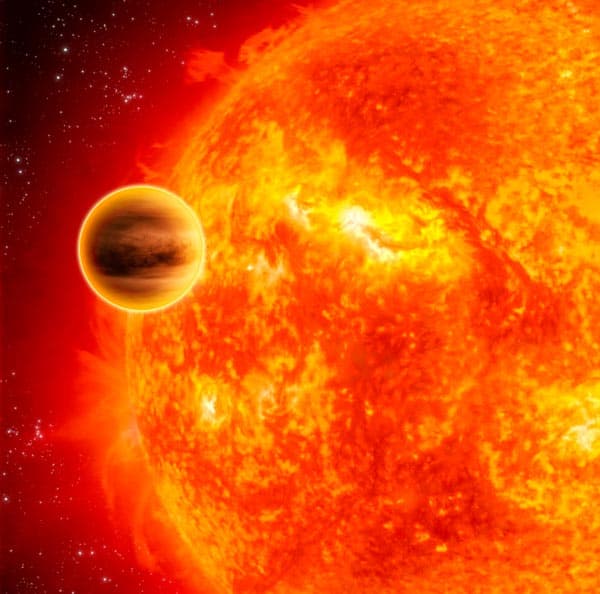Astronomers have discovered an exoplanet that is ten times as heavy as Jupiter but orbits its star in less than a day. According to the current understanding of planet formation and evolution, the scientists have managed to spot the billion-year-old exoplanet about one million years before it is sucked into the star. However, such a sighting should be a relatively rare occurrence, suggesting that physicists may have to reconsider their understanding of how stars interact with their planets.
The new exoplanet is called WASP-18b and belongs to a class known as “hot Jupiters” – so-called because they are about the same size as Jupiter but orbit their stars much more closely than Jupiter orbits the Sun. Almost 375 such exoplanets (planets that orbit stars other than the Sun) have been discovered to date. Astronomers believe that hot Jupiters form far from their companion stars and then migrate inwards over time.
WASP-18b was discovered using the “transit” method – where a planet causes its host star to dim as it passes between the star and Earth – by the WASP South transit survey. The exoplanet’s orbit was then studied independently using radial-velocity observations from the Coralie spectrograph. The latter technique works out the mass and orbital period of an exoplanet from the wobble it induces in its star.
Bulges and torques
WASP-18b is about ten times the mass of Jupiter and orbits its star in 0.94 days, making it the second confirmed hot Jupiter to have an orbital period of less than a day. Because it is so big and so close to its star (it is just three stellar radii away), tidal interactions should elongate both planet and star along the line joining their centres. However, both the star and planet are spinning on their respective axes, and the resulting bulges and torques should cause WASP-18b to spiral inwards so that it is engulfed and destroyed by its star in less than a million years.
Andrew Collier-Cameron of St Andrew’s University in the UK and colleagues in Switzerland, Belgium and the US have shown that that the star is about a billion years old. Stars and their planets are believed to form at the same time, which should make WASP-18b the same age. This means that the team have either caught the exoplanet at a rare moment in its lifetime – as it is just about to be swallowed by the star – or the star is very bad at dissipating the tidal energy between it and the planet. The latter explanation would significantly increase WASP-18b’s lifetime and, if confirmed, would force astronomers to rethink their understanding of tidal interactions in planetary systems and how solar systems evolve.
Another explanation, put forward by Douglas Hamilton of the University of Maryland, who was not involved in the current study, is that WASP-18b may have interacted with another planet after reaching full size (and when it was still relatively far away from its parent star). Such a process might then have pushed WASP-18b closer to the star.
“Or, could something be holding the planet up against the inward drag of tides?” asks Hamilton. “For example, a poorly understood aspect of stellar convection or an unknown subtlety of tides themselves?” All these possibilities need to be examined more closely, he stresses.
Collier-Cameron and colleagues say that if WASP-18b is spiralling rapidly inwards, the effects should become visible to telescopes within as little as a decade and could thus be measured.
The research is reported in the journal Nature.




